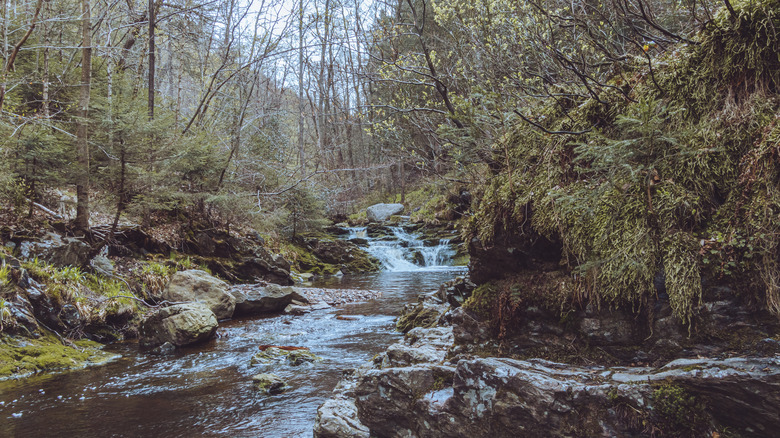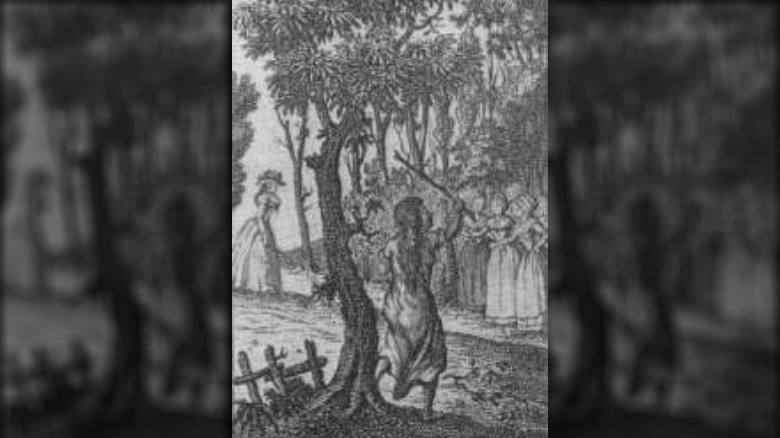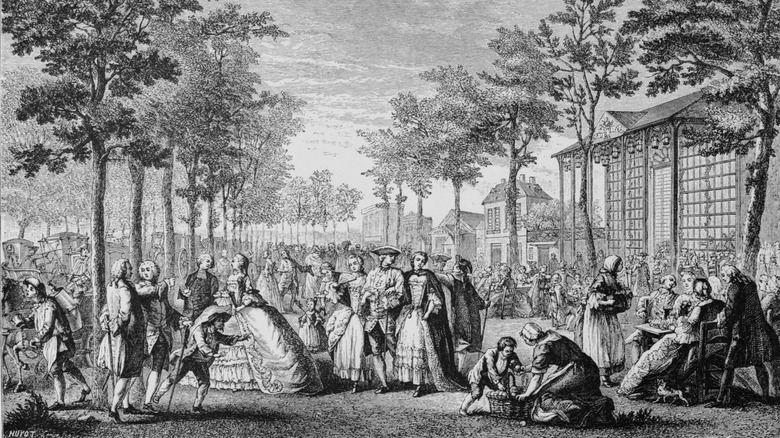The Untold Truth Of The Wild Girl Of Champagne
There's a 300 year period of time from the 17th through the 19th centuries that seems to have been a golden era for feral children in Europe. There are numerous, famous accounts from this time of children who emerged from the wilderness or wandered into a town with no history, sometimes no name, and often little ability to communicate — their entire lives a mystery.
According to History, there was John of Liege who fled his home at a young age to avoid a military attack and wound up spending years alone in the forests of Belgium. There was also Victor of Aveyron, who appeared in France naked and mute, and was prone to get violent if anyone tried to touch him. His story would inspire the 1970 film "The Wild Child," which in turn inspired the 2012 album "L'Enfant Sauvage" by French heavy metal band Gojira. Perhaps most famously, there was Kasper Hauser, a German teenager who arrived in the village of Nuremberg in 1828, with nothing but two notes from an alleged captor who he said kept him locked in a small room for years.
In the 18th century, a young girl appeared in a French village wearing animal skins and a torn dress, brandishing a wooden club. She would become known as the Wild Girl of Champagne.
A mysterious series of sightings
The village of Songy is in the northeastern part of France in the Champagne-Ardenne region. It's among the most heavily forested areas in France, stretching into Belgium, according to Brittanica. So, in short, it's the perfect backdrop to see something mysterious in the wild — but what villagers found was far from anything anyone would expect to be living in the forest.
It was in 1731 when villagers in Songy began seeing something — or someone — peculiar out in the woods. The reports sounded unbelievable. What they were seeing, per History, was a girl between the ages of 10 and 18 wearing only the remnants of a dress and animal skins. According to Timeline, one sighting of this mysterious girl happened when someone spotted her stealing apples from a tree. They would also come to find that this girl wasn't just adept at surviving alone in the wilderness, she was also extremely strong given her size.
The Wild Girl of Champagne is captured
One of the distinguishing characteristics of this mysterious young girl was the wooden club she carried with her. An encounter between the girl and the villagers of Songy showed that she didn't carry that club for fun; she knew how to use it.
It happened, per Timeline, when villagers spotted the girl and sicked their dog on her. Shockingly she killed the dog with her club. This startling show of not just aggression, but competence when it came to wielding that club may have caused some concern. A member of French nobility demanded that the Wild Girl of Champagne be caught. She was, but she still had one last big surprise for the people of Songy.
Villagers lured her out of the wilderness but then they realized the girl didn't speak in the traditional sense. According to History, she made only guttural, animal-like noises. It went another step further: she had a propensity to eat raw meat. She was even observed sinking her teeth into a fresh kill after skinning it on the spot.
The Wild Girl assimilates
It isn't hard to imagine the transition from living in traditional society into having lived alone in the wildlife would be extremely difficult. For the Wild Girl of Champagne, the opposite transition — from the wilderness to life in a small French village — was just as difficult.
After being captured, the Wild Girl was baptized and given the name Marie Angelique Leblanc. She also spent time in a hospital, but this stay caused more problems for the young Leblanc than it solved. Having adapted to consuming raw meat, Leblanc had a hard time eating the cooked food served to her while in the hospital, instead of preferring to gulp down things she had acquired tastes for in the wild like frogs and rabbit's blood, per Timeline. Leblanc's teeth even fell out during this time.
However, she went on to fully recover. Additionally — unlike other feral children in history who were never able to fully acquire language skills — Leblanc learned to speak French fluently. This would allow her to tell the story of how she came to live in the French wilderness.
Marie Angelique Leblanc tells her story
There was a great deal of interest in Leblanc's story in France, and thanks to her ability to speak French fluently she was interviewed several times over the course of her life. One instance was in 1755 when she worked on a biography with writer Marie-Catherine Homassel-Hecquet, per Timeline.
The finished work was called "An Account of a Savage Girl," and according to the book, Leblanc had been abducted from her home in North America where she was sold into slavery around what is now Wisconsin. She was placed aboard a ship headed for France, but according to her account, the ship wrecked and Leblanc washed ashore with another young girl. The two of them learned how to survive in the wild. They would eat anything they could get their hands on whether that was small game or roots that they dug out of the ground. At some point, Leblanc left the other girl and survived in the woods alone.
While it seems almost universally agreed upon that Leblanc was originally native to North America there have been conflicting accounts as to where and what group of people she belonged to. According to History, she was initially thought to be Inuit, but as time went on it was suggested that she was a Meskwaki Indian. However, other accounts allege that she was actually Sioux.
The former Wild Girl enters high society
Despite her non-traditional upbringing — which is admittedly a massive understatement — Marie Angelique Leblanc would find herself mingling with those in the upper-crusts of French society. According to Timeline, after leaving the hospital Leblanc sadly became something of an attraction, with people traveling substantial distances to see her. Later, Leblanc went to live at a convent. This was paid for by a French duke. He also gave her an allowance that was enough for her to move to Paris. Her financier died in 1956, prompting Leblanc to leave the convent.
During this time, Leblanc found herself surrounded by members of French high-society, and at one point even met with Queen Marie, the wife of French ruler King Louis XV. However, the unfortunate reality is that much of the attention stemmed from a then-common belief that Europeans were superior to non-Europeans. Some saw the Leblanc story and her subsequent assimilation into French society as proof of their superiority.
Marie Angelique Leblanc died in 1775, and at the time was wealthy. A stark contrast from the club-wielding young girl who was lured out of the forest decades earlier.





